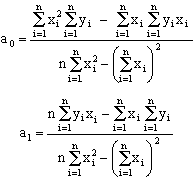|
Least-Squares Polynomial Approximation
Theory If it is known that the measured quantity y (depended variable) is a linear function of x (independent variable), i.e.
the most probable values of a0 (intercept) and a1 (slope) can be estimated from a set of n pairs of experimental data (x1, y1), (x2, y2)…, (xn, yn), where y-values are contaminated with a normally distributed - zero mean random error (e.g. noise, experimental uncertainty). This estimation is known as least-squares linear regression. Least-squares linear regression is only a partial case of least-squares polynomial regression analysis. By implementing this analysis, it is easy to fit any polynomial of m degree
to experimental data (x1, y1), (x2, y2)…, (xn, yn), (provided that n≥m+1) so that the sum of squared residuals S is minimized:
By obtaining the partial derivatives of S with respect to a0, a1, .., am and equating these derivatives to zero, the following system of m-equations and m-unknowns (a0, a1, .., am) is defined:
where:
(obviously it is always: s0 = n) This system is known a system of normal equations. The set of coefficients: a0, a1, …, am is the unique solution of this system. For m=1, the familiar expressions used in linear least-square fit are obtained:
Similar (but by far more complicated) expressions are obtained for coefficients of polynomials of higher degrees. Direct use of these expressions for m>1 are almost never used. Instead, the system of normal equations is set and the solution vector of a0, a1, …, an coefficients is calculated usually with the aid of a computer. The quality of fit is judged by the coefficient of determination (r2):
Applet This applet demonstrates the general polynomial least-squares regression. The user must click n (n≤200) data points (x, y) in the plot area. While clicking, a line appears which is the graphical presentation of the fitted 1-st degree (linear) equation to data. After clicking several points the user can increase (or decrease) the polynomial degree m (1≤m≤12) by clicking the buttons assigned for this purpose. Remember that it must always be: n≥m+1. |



